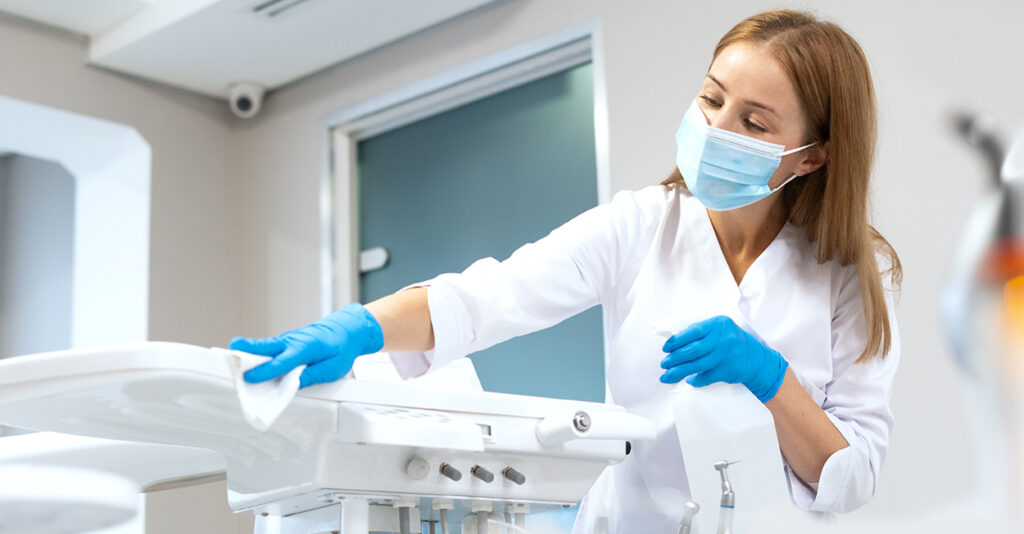
Infection control best practices
In light of recent global health emergencies such as the COVID-19 pandemic and monkeypox, and with flu season fast approaching, infection control is more crucial now than it’s ever been before.
Infection control prevents or stops the spread of infections in dental settings and is vital for the safety of your patients and dental team. It’s a process that involves continuing education, engineering protocols, vigilance and a commitment to follow proven step-by-step measures.
The following steps, from dental consultant Dr. Michael Tarighati, take into consideration the latest knowledge gained from the pandemic, particularly concerning aerosol spread, to help you achieve infection control best practices and ensure that your facility is clean and safe.
Patient treatment areas
Start of the day
- Wash your hands thoroughly with antibacterial soap and water before appointments and after any interruptions. Keep your fingernails trimmed and make sure they have smooth, filed edges to allow thorough cleaning and prevent glove tears.
- Wear personal protective equipment (PPE), including gloves, masks (level 1, 2, 3, N-95 respirators), protective eyewear with side shields, reusable water repellant lab coats or disposable gowns, head bouffant and face shields.
- Flush your high-speed handpiece hose for at least three minutes to clear any residual water in the tubing before connecting the handpiece. The CDC recommends using a dental unit water that meets the regulatory standards set by the Environmental Protective Agency (EPA) for drinking water, which must have fewer than 500 colony-forming units (CFU/mL) of heterotrophic water bacteria.
- Inspect the anti-retractive valve in each air-water syringe to prevent backflow of water.
- Fill each dental unit water container with distilled water.
- Flush water from the air-water syringe for one minute, and for at least 30 seconds between patients.
- Disinfect environmental surfaces with the “wipe-discard-wipe” technique. Wipe the surface with a disinfectant wipe to clean it, discard the wipe and then use another wipe to disinfect it. Do not spray disinfectant directly on surfaces, and limit spraying to procedures such as disinfecting dental impressions. Disinfect any surface with which you, your staff or your patients might come into contact, including:
- Doctor and dental assistant chairs
- Dental chair switches and arms
- Lamp switches and handles
- Hose ends
- Bracket table handle edges
- Handpiece holders and levers
- Air-water syringe tip
- Evacuator/ejection couplings
- Drawer handles
- Top of mobile unit
- Countertops
- Digital radiograph unit
- Intraoral camera
- Digital intraoral scanner
- Composite applicator
- Impression mixing cartridge dispenser gun
- Reusable dental materials
- Cover the bracket table and countertop with a polyvinyl or cover and place a paper tray liner on the patient tray to minimize surface contact with contaminated disposables.
- Place disposable barrier sleeves on light curing units, digital radiograph sensors and other dental material syringes.
- Leave instruments unopened in their pouch or cassette.
- Calibrate the dental ultrasonic cleaner unit in the sterilization area with distilled water and enzymatic ultrasonic solution.
- Have your patient rinse with an antibacterial mouthwash before starting the procedure.
- Remove your gloves and wash your hands thoroughly before leaving the operatory.
- Discard reusable gowns in a dedicated hamper.
During each dental appointment
- Adhere to good work practices. Wash your hands if you leave the operatory, replace gloves that are torn, cut or punctured, and discard gloves before leaving the operatories.
- Clean and wipe down clinical contact surfaces between patient visits with an EPA-registered low-level or intermediate-level surface disinfectant. The benchmark organism used to assess intermediate (or higher) level disinfectants is Mycobacterium tuberculosis (TB), because it’s comparatively difficult to destroy. Tuberculocidal action ensures that the product will destroy all important pathogens found in medical and dental environments, referred to as “TB kill.”
- Avoid injury with sharp instruments and needles. Manage sharp instruments carefully and use a needle shield. Use the one-handed scoop technique to recap needles.
- Place all sharp items, such as needles, ends of sutures, burs and broken instruments, in appropriate red puncture-resistant containers mounted to the wall, and ensure that the container doesn’t reach its full capacity. Ideally, use Isolyzer in each dental operatory, ensuring that it’s within its six months of use.
- Place soiled gauze and cotton rolls in biohazard bags.
- Flush water from your high-speed handpiece hose and air-water syringe for at least 20 to 30 seconds between patient visits to clear any residual water in the tubing.
- Put on heavy utility gloves when transferring dirty instruments to the sterilization center. Each dental assistant team member must have dedicated utility gloves.
- Transfer contaminated instruments in a cassette.
- Remove gloves when you open cabinets and drawers to minimize cross contamination.
- Discard dirty reusable lab coats in a dedicated hamper.
End of the day
- Remove gloves and wash your hands. Put on heavy utility gloves when transferring a dirty instrument via cassette to the sterilization center.
- Discard reusable gowns in a dedicated hamper.
- Clean up disposables in the operatory. Wipe countertops, mobile cabinets and sinks with antibacterial soap and water.
- Disinfect each dental unit with disinfecting wipes, including the chair, operating doctor and dental assistant chairs, hoses and the bracket tabletop.
- For surgical procedures, remove and replace the screen in the saliva ejector and insert a new waterline cleansing tablet.
- Shock both the high-volume evacuation (HVE) line and slow-speed evacuation line with a gallon of water mixed with shocking agent.
- Shock the dental HVE system in each dental operatory with dental evacuation system agents.
- Drain the dental ultrasonic cleaner unit in the sterilization area. Don’t leave instruments out overnight and place them in sterilization pouches or cassettes.
- Housekeeping surfaces such as cabinets, walls, and floors must be cleaned and disinfected regularly with a low-level disinfectant with detergent, especially when spills occur or these surfaces are visibly soiled. Vacuum and mop the floors with a low-level disinfectant, such as bleach and water. Avoid sweeping the floor to prevent creating aerosol.
At the beginning of each week
- Disinfect each dental operatory with disinfecting wipes, including the chair, operating doctor and dental assistant chairs, hoses and the bracket tabletop.
- Run a spore test for the autoclave. Repeat the spore test if the first test is positive. If positive results continue, contact your dental supply company for maintenance.
- Maintain autoclave weekly cleaning protocols.
- Vacuum and mop the floors with a low-level disinfectant, such as bleach and water. Avoid sweeping the floor to prevent creating aerosol.
At the beginning of each month
- Maintain autoclave monthly cleaning protocols.
- Evaluate your eyewash station to ensure it’s functioning properly.
- Inspect the anti-retractive valve in each air-water syringe.
- Inspect your compressor unit.
- Inspect your amalgam separator unit.
- Inspect the water from each dental unit in each operatory, especially if you use tap water rather than distilled water.
- Inspect the air conditioner and heater air filters throughout the office.
Dental laboratory areas
- Change the lathe after polishing a removable denture, complete denture, nightguard, sports guard or snore guard appliance. Transfer the dirty lathe to the sterilization area to be sterilized.
- Change the acrylic or diamond bur after each adjustment of fixed or removable prosthodontic appliances, such as crowns, and transfer the dirty bur in a bur block to the sterilization area to be sterilized.
- Disinfect the countertops, the dental laboratory lathe machine, sandblaster unit and dental laboratory handpiece.
- Vacuum and mop the floors with a low-level disinfectant, such as bleach and water.
- Use your office washing machine to clean all dirty lab coats with bleach and detergent, and then put them in the dryer. Don’t wash patient blankets with lab coats.
Front office areas
- Ensure that dental team members who leave dental operatory areas discard their gowns or gloves to avoid cross-contamination to the front office and patient reception areas.
- Provide hand sanitizer, and ask patients to apply it when they check in.
- Reschedule patients who appear to be sick.
- Use gloves when using disinfecting wipes to disinfect the areas, including countertops, computer monitors, pens, the front door handle and the payment terminal machine.
- Vacuum and mop the floors with a low-level disinfectant, such as bleach and water.
By taking these measures, you’ll continue to keep your patients and team member’s health and wellbeing a priority, ensuring that they’re safe from spread of infection and illness. Remember, always adhere to Standard Precautions, which are the minimum infection prevention practices for all patient care, regardless of the status of their health, in any health care setting, including dentistry. For more information, review the infection control guidelines set forth by the CDC.
Recent posts
- Start the year strong: Key reminders to support your practice in 2026
- Discover 3 tips to power up your practice with new workflows
- Updated 2026 CDT codes are here
- Partner with us to improve the health outcomes of our shared members
- Say hello to our 2026 Medicare Advantage DHMO partners
- Say hello to our 2026 Delta Dental Medicare Advantage™ PPO partners
- Insights from Dr. Allen Edwards on oral cancer detection and prevention
- Create a PPO strategy for your dental practice
- Dr. Brian Hathcoat — how a career change and a commitment to service made a positive impact
- Menopause and the mouth: What our survey results are saying
